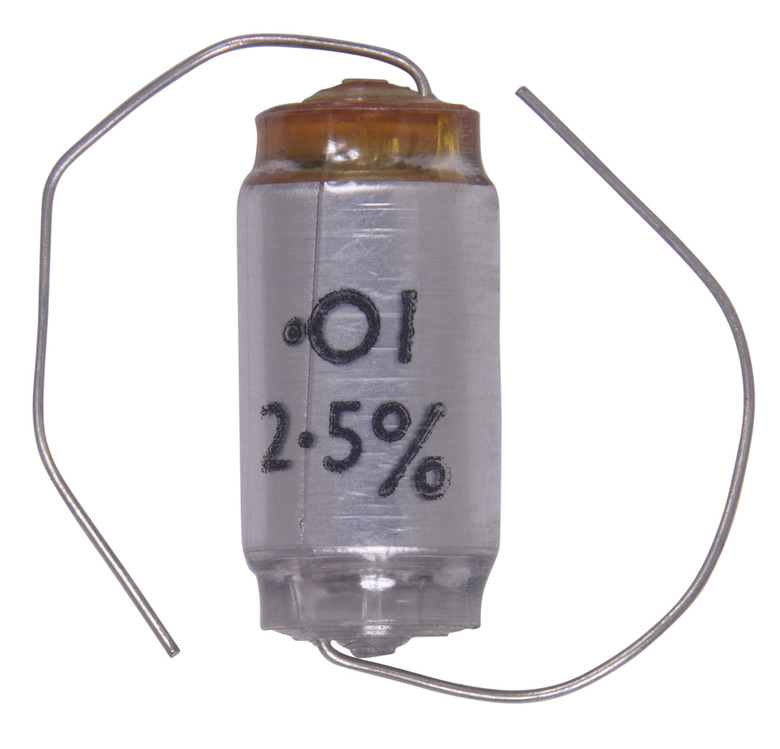Types & Functions Of Capacitors
Capacitors are electrical devices that store energy, and they are in most electrical circuits. The two major types of capacitors are polarized and non-polarized. The way in which a number of capacitors are connected determines their value in a circuit. Their combined value is highest when they are connected in a series, positive to negative. Their combined value is lowest when they are connected in parallel, end to end. Capacitors combined with resistors and inductors in a circuit are used in electrical timing of events as well as in motors, fans, televisions, automobiles and many other consumer products and high-energy environments.
Polarized Capacitors
Polarized Capacitors
Some capacitors have distinct positive and negative poles. They are called polarized capacitors. The value of a capacitor is measured in capacitance, and capacitance is measured in units of Farad. Most capacitors usually have small Farad values called micro-Farad (uF) and pico-Farad. A capacitor is designed in one of two formats: radial or axial. In the radial design, both leads of the capacitor are at the same end; in the axial design, the leads are at each end of the capacitor. Polarized capacitors are usually big and electrolytic and are designed for direct current (DC) circuits. They usually have high capacitance. The disadvantages of polarized capacitors are that they have low breakdown voltage, shorter lifetimes and higher leakage of current.
Non-Polarized Capacitors
Non-Polarized Capacitors
Most non-polarized capacitors are not electrolytic and do not have a specific positive or negative pole. They are also called bipolar capacitors. Used more often in alternating current (AC) circuits, they usually have small capacitance values in the micro-Farad and nano-Farad range. Some non-polarized capacitors tolerate voltage fluctuations up to 200 volts without breaking down. They are used in computers, motherboards and simple circuit boards. Non-polarized capacitors are inexpensive and made of ceramic and mica, though a few are electrolytic.
Functions in Electrical Circuits
Functions in Electrical Circuits
Capacitors are used in electronic circuits as low-pass, high-pass and band filters. A filter is a circuit that allows current and voltage of a specified frequency and waveform to pass through. A capacitor's reactance is inversely proportional to frequency. By controlling or changing the reactance, you can control the frequency allowed through the circuit. Capacitors also play a significant role in high-speed switching logic circuits. Such circuits' voltage level, which should be steady, can change with current fluctuation, thereby introducing noise or error signals. Decoupling capacitors are built into circuits to stabilize the current, minimizing noise signals.
High-Voltage Applications
High-Voltage Applications
High-voltage capacitors have many applications in power supplies, inverters and flash lamps. They are used in X-ray machines and laser systems. Spot-welding uses capacitive power supply systems, and high-power microwave (HPM) systems have high-power capacitors. HPM systems are used in defense to disable electronic equipment. They produce short bursts of high-power microwave energy, lethal to electronics but harmless to humans. Banks of high-power capacitors can store tremendous power and can be programmed to discharge or deliver energy to electrical systems experiencing a blackout.
Cite This Article
MLA
PaulI, O. "Types & Functions Of Capacitors" sciencing.com, https://www.sciencing.com/types-functions-capacitors-11372138/. 24 April 2017.
APA
PaulI, O. (2017, April 24). Types & Functions Of Capacitors. sciencing.com. Retrieved from https://www.sciencing.com/types-functions-capacitors-11372138/
Chicago
PaulI, O. Types & Functions Of Capacitors last modified March 24, 2022. https://www.sciencing.com/types-functions-capacitors-11372138/


